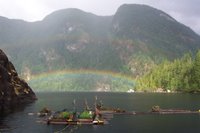Coastal BC Animals: Chipmunks
 |
| Joining the birds for a snack. |
If there is food in the bird feeder they stop by for a try to get their share. Consequently, the Juncos have to go without for a few days between fillings.
If the feeder is empty, they boldly come on the deck to see why we aren't attending to their needs. Many forest critters like to eat my crops growing in pots and containers on the decks. At least the chipmunks are polite about not digging into our growing food supply.
Visitors from Powell River report that there are few chipmunks left in town. They surmise that the growing gray and black squirrel population may be pushing the cute little guys farther into the bush.
Chipmunks can be distinguished by the stripes on their face and back. Their colouring is yellowish to brownish gray with black and white stripes. Often there is a reddish cast to their sides.
Chipmunks are very energetic and agile. We see them climb the nearly vertical granite cliffs next to the cabin.
There are four varieties listed for BC. I'm not sure which kind come to visit us. It might be a Red-Tailed. Can you help?
Here's a link to a good (and free) manual for identifications: An Identification Manual to the Small Mammals of British Columbia. -- Margy
References: BC Adventure (online) and Nature Canada (online).
























































